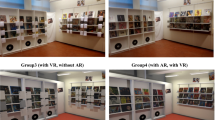Abstract
The increasing complexity and the technology advancement of equipment pose challenges to the maintenance technicians nowadays. Augmented reality (AR) technology can be used to assist the maintenance technicians by providing useful information through visual interactions, e.g., superimposing the maintenance instructions virtually on the real equipment. However, to improve the usability of the state-of-the-art AR-assisted maintenance systems in routine and ad hoc maintenance activities, the virtual information provided should be adapted to the various contexts, i.e., context relevant. For example, the information provided should accord to the status of the activity and the user’s expertise level. In addition, the rendered AR contents should not be “read-only”, such that the maintenance technicians become passive information receivers. Providing the technicians with the means to interact with the AR contents actively is useful as they can rectify any incorrect AR contents that have been created by the AR developers and author AR contents to record and share the accumulated knowledge and experience on equipment maintenance with other technicians. In this paper, an authorable context-aware AR System (ACARS) is proposed to assist the maintenance technicians. To make ACARS context-aware and authorable, a bi-directional authoring tool, which enables the AR developers to create context-relevant information via a desktop 2D user interface and the maintenance technicians to author AR contents on-site, is proposed. A prototype system has been developed, and a case study has been conducted to demonstrate the usability of ACARS.
Similar content being viewed by others
References
Campos J, Jantunen E, Prakash O (2009) A web and mobile device architecture for mobile e-maintenance. Int J Adv Manuf Technol 45(1–2):71–80
Setchi R, White D (2003) The development of a hypermedia maintenance manual for an advanced manufacturing company. Int J Adv Manuf Technol 22(5–6):456–464
Zhou F, Duh HB-L, Billinghurst M (2008) Trends in augmented reality tracking, interaction and display: a review of ten years of ISMAR. 7th IEEE International Symposium on Mixed and Augmented Reality, Cambridge UK, pp 193–202
Dey AK (2001) Understanding and using context. Pers Ubiquit Comput 5(1):4–7
Byun HE, Cheverst K (2004) Utilizing context history to provide dynamic adaptations. Appl Artif Intell 18(6):533–548
Feiner S, Macintyre B, Seligmann D (1993) Knowledge-based augmented reality. Commun ACM 36:53–62
Friedrich W (2002) ARVIKA-augmented reality for development, production and service. International Symposium on Mixed and Augmented Reality, Darmstadt, Germany, pp 3–4
Schwald B, Figue J, Chauvineau E, Hong FV, Robert A, Arbolino M, Schnaider M, de Laval B, de Rauly FD, Anez FG, Baldo O, Santos J (2001) STARMATE: using augmented reality technology for computer guided maintenance of complex mechanical elements. Proceedings of eBusiness and eWork Conference (e2001), Venice-Italy, October 2001, pp 17–19
Savioja P, Järvinen P, Karhela T, Siltanen P, Woodward C (2007) Developing a mobile, service-based augmented reality tool for modern maintenance work. Proceedings of the 2nd international conference on Virtual Reality, Beijing, China, pp 554–563
ARTESAS—advanced augmented reality technologies for industrial service applicationshttp://www.artesas.de
Lee S, Akin O (2011) Augmented reality-based computational fieldwork support for equipment operations and maintenance. Autom Constr 20(4):338–352
Didier JY, Roussel D (2005) AMRA: augmented reality assistance for train maintenance tasks. ISMAR’05: Workshop on Industrial Augmented Reality pp xvii–xviii
Klein G, Murray D (2007) Parallel tracking and mapping for small AR workspaces. International Symposium on Mixed and Augmented Reality, Nara, Japan, pp 225–234
Goose S, Sudarsky S, Zhang X, Navab N (2003) Speech-enabled augmented reality supporting mobile industrial maintenance. IEEE Pervas Comput 2(1):65–70
Park HM, Lee SH, Choi JS (2008) Wearable augmented reality system using gaze interaction. 7th IEEE International Symposium on Mixed and Augmented Reality, Cambridge, UK, pp 175–176
Jacob RJK (1993) Eye-movement-based human–computer interaction techniques: toward non-command interfaces. Advances in human–computer interaction. Ablex, Norwood, New Jersey, vol 4, chapter 6, pp 151–190
Henderson SJ, Feiner S (2010) Opportunistic tangible user interfaces for augmented reality. IEEE Trans Vis Comput Graph 16(1):4–16
Fantini M, Persiani F, Di Stefano L, Azzari P, Salti S (2011) Augmented reality for aircraft maintenance training and operations support. IEEE Comput Graph Appl 31(1):96–101
Sakata N, Kurata T, Kuzuoka H (2006) Visual assist with a laser pointer and wearable display for remote collaboration. Trans Virtua Real Soc Jap 11(4):561–568
Lee JY, Rhee G (2008) Context-aware 3D visualization and collaboration services for ubiquitous cars using augmented reality. Int J Adv Manuf Technol 37(5–6):431–442
Haringer M and Regenbrecht HT (2002) A pragmatic approach to augmented reality authoring, the International Symposium on Mixed and Augmented Reality (ISMAR’02), Washington, DC, pp 237–245
Zauner J, Haller M, Brandl A, Hartman W (2003) Authoring of a mixed reality assembly instructor for hierarchical structures, the International Symposium on Mixed and Augmented Reality (ISMAR’03), Tokyo, Japan, pp 237–246
Knopfle C, Weidenhausen J, Chauvigne L, Stock I (2005) Template based authoring for AR based service scenarios, 2005 IEEE Conference on Virtual Reality (VR’05), Bonn, Germany, pp 249–252
Zhu J, Ong SK, Nee AYC (2011) Online authoring for augmented reality remote maintenance, the 12th IASTED International Conference on Computer Graphics and Imaging, CGIM 2011, Innsbruck, Austria, pp 87–94
SWRL: A semantic web rule language combining OWL and RuleML, http://www.w3.org/Submission/SWRL/
Pellet: OWL 2 Reasoner for Java, http://clarkparsia.com/pellet
Yuan ML, Ong SK, Nee AYC (2004) The virtual interaction panel: an easy control tool in augmented reality systems. Comp Anima Virtua Worlds J, Special Issue: The Very Best Papers from CASA 2004, vol 15, no 3–4, pp 425–432
HITLabNZ ARToolkit (2005), http://www.artoolkit.sourceforge.net/
The OWL API, http://owlapi.sourceforge.net/
Shen Y, Ong SK, Nee AYC (2011) Vision-based hand interaction in augmented reality environment. Int J Hum Comput Interact 27(6):523–544
Nee AYC, Ong SK, Chryssolouris G and Mourtzis D (2012) Augmented reality applications in design and manufacturing. Annals of CIRP, Vol 61, no 2
Author information
Authors and Affiliations
Corresponding author
Rights and permissions
About this article
Cite this article
Zhu, J., Ong, S.K. & Nee, A.Y.C. An authorable context-aware augmented reality system to assist the maintenance technicians. Int J Adv Manuf Technol 66, 1699–1714 (2013). https://doi.org/10.1007/s00170-012-4451-2
Received:
Accepted:
Published:
Issue Date:
DOI: https://doi.org/10.1007/s00170-012-4451-2




